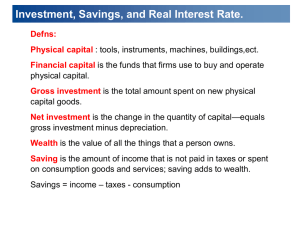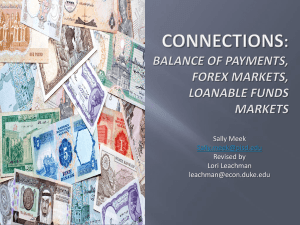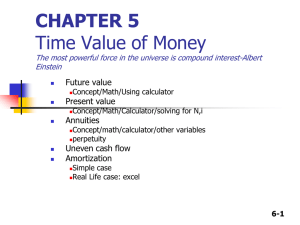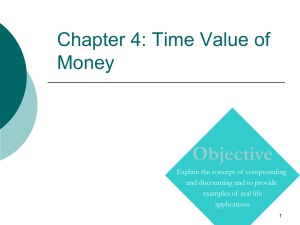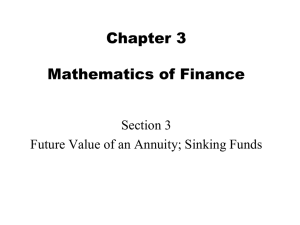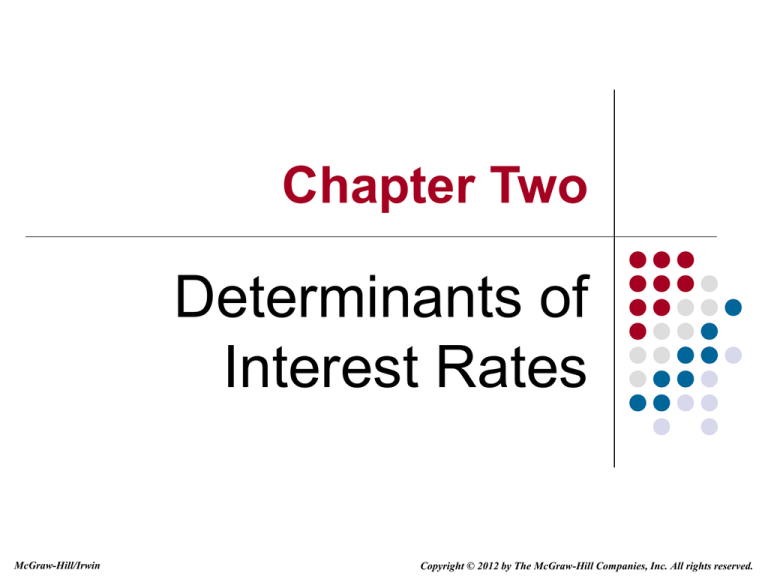
Chapter Two
Determinants of
Interest Rates
McGraw-Hill/Irwin
Copyright © 2012 by The McGraw-Hill Companies, Inc. All rights reserved.
Interest Rate Fundamentals
Nominal interest rates: the interest rates
actually observed in financial markets
Used to determine fair present value and prices of
securities
Two types of components
Opportunity cost
Adjustments for individual security characteristics
2-2
Real Interest Rates
Additional purchasing power
required to forego current
consumption
What causes differences in nominal and real interest
rates?
If you wish to earn a 3% real return and prices are
expected to increase by 2%, what rate must you charge?
Irving Fisher first postulated that interest rates contain a
premium for expected inflation.
2-3
Loanable Funds Theory
Loanable funds theory explains interest rates
and interest rate movements
Views level of interest rates in financial markets
as a result of the supply and demand for
loanable funds
Domestic and foreign households, businesses,
and governments all supply and demand
loanable funds
2-4
Supply and Demand of Loanable
Funds
Demand
Supply
Interest
Rate
Quantity of Loanable Funds
Supplied and Demanded
2-5
Net Supply of Funds in U.S. in
2010
Source Federal
Reserve Flow of
Funds Matrix
Net Supply in Billions
Year 2010 data
of Dollars
Households & NPOs
$ 786.9
Business
Nonfinancial
75.3
State & Local Govt.
-19.3
Federal Government
-1378.6
Financial Sector
-178.3
Foreign
324.3
Totals (Discrepancy)
-$389.7
2-6
Source: Federal Reserve Bank of St.
Louis
2-7
Determinants of Household
Savings
1.
2.
3.
4.
5.
Interest rates and tax policy
Income and wealth: the greater the wealth or
income, the greater the amount saved,
Attitudes about saving versus borrowing,
Credit availability, the greater the amount of
easily obtainable consumer credit the lower the
need to save,
Job security and belief in soundness of
entitlements,
2-8
Determinants of Foreign Funds
Invested in the U.S.
1.
2.
3.
4.
Relative interest rates and returns on global
investments
Expected exchange rate changes
Safe haven status of U.S. investments
Foreign central bank investments in the U.S.
2-9
Determinants of Foreign Funds
Invested in the U.S.
Country
China
Saudi Arabia
Russia
Taiwan
S. Korea
Foreign Currency Reserves
(all $ in billions)
$2,847
456
444
382
292
Source: Economist, February 2011
2-10
Federal Government Demand for
Funds
report
Source:Source:
CBO CBO
20112011
report,
http://www.cbo.gov/ftpdocs/74xx/doc7492/08-17BudgetUpdate.pdf
2-11
Federal Government Demand for
Funds
Federal debt held by the public was at $9.0
trillion at end of 2010 (62% GDP) and is
projected to grow to $17.4 trillion by 2020 (76%
of projected 2020 GDP, 120% of current GDP)
Large potential for crowding out and/or
dependence on foreign investment
2-12
Federal Government Demand for
Funds
Total Federal Debt is currently $14.1 trillion (97%
GDP) and is projected to grow to $23.1 trillion by
2020 (64% increase)
o
Interest expense is projected to grow to
3.5% of GDP by 2020
2-13
Shifts in Supply and Demand Curves
change Equilibrium Interest Rates
Increased supply of loanable funds
Interest
Rate
Interest
Rate
SS
DD
Increased demand for loanable funds
SS*
DD
DD*
i**
i*
i*
E*
Q* Q**
E*
E
E
i**
SS
Quantity of
Funds Supplied
Q* Q**
Quantity of
Funds Demanded
2-14
Factors that Cause Supply and
Demand Curves to Shift
Increase in
Affect on Supply
Affect on Demand
Wealth & income
Increase
N/A
As wealth and income increase, funds suppliers are more willing to supply funds
to markets. Result: lower interest rates
Risk
Decrease
Decrease
As the risk of an investment decreases, funds suppliers are less willing to
purchase the claim. All else equal, demanders of funds would be less willing to
borrow as well. Result: higher interest rates
Near term spending needs
Decrease
N/A
As current spending needs increase, funds suppliers are less willing to invest.
Result: higher interest rates
Monetary expansion
Increase
N/A
As the central bank increases the supply of money in the economy, this directly
increases the supply of funds available for lending. Result: lower interest rates
2-15
Factors that Cause Supply and
Demand Curves to Shift
Increase in
Affect on Supply
Affect on Demand
Economic growth
Increase
Increase
With stronger economic growth, wealth and incomes rise, increasing the supply of funds
available. As U.S. economic strength improves relative to the rest of the world, foreign
supply of funds is also increased. Business demand for funds increases as more projects
are profitable. Result: indeterminate effect on interest rates, but at more rapid growth
rates interest rates tend to rise.
Utility derived from assets
Decrease
Increase
As utility from owning assets increases, funds suppliers are less willing to invest and
postpone consumption whereas funds demanders are more willing to borrow. Result:
higher interest rates
Restrictive covenants
Increase
Decrease
As loan or bond covenants become more restrictive, borrowers reduce their demand for
funds. Result: lower interest rates
2-16
Factors that Cause Supply and
Demand Curves to Shift
Increase in
Affect on Supply
Affect on Demand
Tax Increase
Decrease
Increase
Taxes on interest and capital gains reduce the returns to savers and the incentive to save.
The tax deductibility of interest paid on debt increases borrowing demand. Result:
Higher interest rates
Currency Appreciation
Increase
N/A
Foreign suppliers of funds would earn a higher rate of return if the currency appreciates
and a lower rate of return measured in their own currency if the dollar depreciates.
Foreign central banks often buy U.S. Treasury securities as part of their attempts to
prevent their currency from appreciating against the dollar.
Result: Lower interest rates
Expected inflation
Decrease
Increase
An increase in expected inflation implies that suppliers will be repaid with dollars that
will have less purchasing power than originally anticipated. Suppliers lose purchasing
power and borrowers gain more than originally anticipated. This implies that supply will
be reduced and demand increased. Result: Higher interest rates
2-17
Determinants of Interest Rates
for Individual Securities
ij*
= f(IP, RIR, DRPj, LRPj, SCPj, MPj)
Inflation (IP)
IP = [(CPIt+1) – (CPIt)]/(CPIt) x (100/1)
Real Interest Rate (RIR) and the Fisher
effect
RIR = i – Expected (IP)
2-18
Determinants of Interest Rates
for Individual Securities (cont’d)
Default Risk Premium (DRP)
DRPj = ijt – iTt
ijt = interest rate on security j at time t
iTt = interest rate on similar maturity U.S. Treasury
security at time t
Liquidity Risk (LRP)
Special Provisions (SCP)
Term to Maturity (MP)
2-19
Term Structure of Interest Rates:
the Yield Curve
(a) Upward sloping
(b) Inverted or downward
sloping
(c) Flat
Yield to
Maturity
(a)
(c)
(b)
Time to Maturity
2-20
Unbiased Expectations Theory
Long-term interest rates are geometric averages
of current and expected future short-term
interest rates
RN [(11 R1 )(1 E ( 2 r1 ))...(1 E ( N r1 ))] 1
1/ N
1
1RN
= actual N-period rate today
N = term to maturity, N = 1, 2, …, 4, …
1R1 = actual current one-year rate today
E(ir1) = expected one-year rates for years, i = 1 to N
2-21
Liquidity Premium Theory
Long-term interest rates are geometric averages
of current and expected future short-term
interest rates plus liquidity risk premiums that
increase with maturity
1/ N
R
[(
1
R
)(
1
E
(
r
)
L
)...(
1
E
(
r
)
L
)]
1
1
N
1 1
2 1
2
N 1
N
Lt = liquidity premium for period t
L2 < L3 < …<LN
2-22
Market Segmentation Theory
Individual investors and FIs have specific
maturity preferences
Interest rates are determined by distinct supply
and demand conditions within many maturity
segments
Investors and borrowers deviate from their
preferred maturity segment only when
adequately compensated to do so
2-23
Implied Forward Rates
A forward rate (f) is an expected rate on a shortterm security that is to be originated at some
point in the future
The one-year forward rate for any year N in the
future is:
f1 [(11 RN ) /(11 RN 1 ) ] 1
N
N
N 1
2-24
Time Value of Money and Interest
Rates
The time value of money is based on the
notion that a dollar received today is
worth more than a dollar received at some
future date
Simple interest: interest earned on an
investment is not reinvested
Compound interest: interest earned on an
investment is reinvested
2-25
Present Value of a Lump Sum
Discount future payments using current interest
rates to find the present value (PV)
PV = FVt[1/(1 + r)]t = FVt(PVIFr,t)
PV = present value of cash flow
FVt = future value of cash flow (lump sum) received in t
periods
r = interest rate per period
t = number of years in investment horizon
PVIFr,t = present value interest factor of a lump sum
2-26
Future Value of a Lump Sum
The future value (FV) of a lump sum
received at the beginning of an
investment horizon
FVt = PV (1 + r)t = PV(FVIFr,t)
FVIFr,t = future value interest factor of a lump sum
2-27
Relation between Interest Rates
and Present and Future Values
Present
Value
(PV)
Future
Value
(FV)
Interest Rate
Interest Rate
2-28
Present Value of an Annuity
The present value of a finite series of equal
cash flows received on the last day of equal
intervals throughout the investment horizon
1 (1 i )t
PV PMT [1/(1 r )] PMT
i
j 1
PMT = periodic annuity
payment
t
j
PVIFAr,t = present value interest factor of an annuity
2-29
Future Value of an Annuity
The future value of a finite series of equal cash
flows received on the last day of equal intervals
throughout the investment horizon
t 1
(1 i )t 1
FVt PMT (1 r ) PMT
i
j 0
FVIFAr,t = future value interest factor of an annuity
j
2-30
Effective Annual Return
Effective or equivalent annual return
(EAR) is the return earned or paid over a
12-month period taking compounding
into account
EAR = (1 + rper period)c – 1
c = the number of compounding periods per year
2-31
Financial Calculators
Setting up a financial calculator
Number of digits shown after decimal point
Number of compounding periods per year
Key inputs/outputs (solve for one of five)
N = number of compounding periods
I/Y = annual interest rate
PV = present value (i.e., current price)
PMT = a constant payment every period
FV = future value (i.e., future price)
2-32






